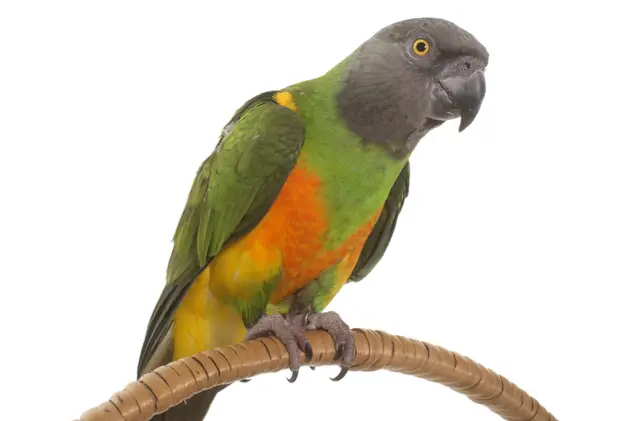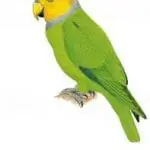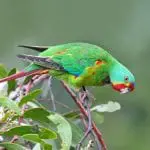Scientific Facts
| Common Name: | Senegal Parrot |
| Scientific Name: | Poicephalus Senegalus |
| Life Span: | 30+ years |
| Size: | About 9 inches |
| Habitat: | Open woodland and Savanna |
| Captive Status: | Least Concern |
| Housing: | Spacious enclosure |
| Nest Box Size: | 36” x 26” x 48” |
| Clutch Size: | 3 to 4 eggs |
| Incubation Time: | 27 to 28 days |
| Fledging Age: | 3 to 4 years |
| Hatch Weight: | 120 to 170 grams |
| Country of Origin: | West Africa |
Senegal Parrot Information
The scientific name of Senegal Parrot is Poicephalus Senegalus. This specific species has three races: P.S. Mesotypus, P.S Versteri, and P.S. Senegalus. The main difference lies in its colors, leading to their alternative common names.
Physical Description
For a parrot of its size, the Senegal Parrots have a big head and beak. They also have broad, short tails. Senegals are usually a bit stockier compared to other smaller parrots. Younger Senegal Parrots typically have brown eyes which change to orange or yellow as the bird continues to mature.
Even though these birds are quiet compared to other parrots, they are often heard whistling and chattering softly. Groups of Senegals in the wild are quite social, whistling and chirping to each other throughout the day. They even screech loudly when they feel excited.
Calls/Vocalizations
Aside from merely copying sounds, Senegal parrots are also known to have their very own repertoire of vocalizations, including squalls, piercing shrieks, whistles, and screams. One thing to note is that if a parrot feels hyper, they usually show off some loud behaviors. Even though Senegal parrots, in general, are quieter than many birds, they usually have their noisy spells.
Color
Senegal Parrots are mostly dark green in color, with brownish-gray features. They have an iridescent green throat, yellow chest, and orange thighs.
Personality

Senegal Parrots are birds who love attention. If you want to have a Senegal of your own, make sure that you have time to spend with it every day. This means allowing your bird to see your presence in the same room for a time. It is also recommended to have them out of their cage at least one hour a day.
Senegals are also friendly to everybody. However, they are territorial, which means that they also have a tendency to strongly bond with an individual at home. They also tend to be jealous, which may result in aggression towards other people. Because of this, it is recommended to have these birds interact and be familiar with all members of the family so that they will not bond to one person only. Note that Senegals are not ideal for children, as feeling territorial might result in biting.
These birds may also be aggressive and unfriendly towards newcomers in their cage. As such, it is very important to exercise care when getting a second bird. A separate cage may be needed. It is not possible to force bonding between them, as it may never even happen at times. In certain situations, they may become friendly with another bird, but this, not a common case.
Life Span
In captivity, Senegal Parrots can reach up to 40 years. Just like humans, a lack of exercise can easily lead to diminished health an overweight. These birds are also prone to common respiratory problems, and may even have issues regarding excessive growth of beak. This may be a sign of a liver problem, something that an avian vet should look into.
Reproduction
There is not much available information regarding the way Senegal Parrots breed in the wild. It is known, however, that they build their nest in tall trees, and that their mating season happens from September to November.
When taken in captivity, Senegals are often housed in pairs in a well-prepared aviary. Females reach sexual maturity around 2 years of age, while the males reach this level of sexual maturity at 3 years. Still, they may not breed until a later time, even at 6 to 7 years.
Female Senegals usually lay 2 to 4 eggs at a time. The incubation of these eggs usually lasts for about 25 to 28 days. The young Senegals start to venture out at around 9 weeks old, though they do not become completely independent until they reach 12 weeks.
Behavior

In a natural environment, Senegal Parrots live either alone or in pairs. At times, they group together in small flocks of about 10 to 20 birds. They are typically excited around humans and typically fly high above tall treetops. They usually let out of a series of whistling noises and short screeches. When they are alarmed, the call can be piercing and loud.
As pets, they are generally very playful and friendly. They love chewing on their favorite toy, wood, or other bird toys. Among the most interesting capabilities of Senegals is mimicking household noises and sounds. At times, they can even pick up some words, or short phrases. They may even learn some very simple tricks.
In general, they can get along pretty well with other birds, though they have the tendency to get jealous. As such, they could go as far as chasing around a family pet and may bite. They usually love attention and enjoy being attached to one person, though they can shift their devotion to another person when they have doted more.
Feather plucking, biting, and screaming are among the common behavior problems of Senegal Parrots. A way to eliminate these behaviors is to make sure that your parrot is given lots of toys, plenty of space, and plenty of attention. They behave this way because of loneliness, boredom, and frustration. They are social parrots, which means that they need daily stimulation both in and out of their cage. Parrots that spend most of their time in a poorly furnished cage are most likely to display these behavioral problems.
Food and Diet
In a natural habitat, Senegal Parrots eat a wide variety of seeds, as well as plants, fruits, blossoms, greens, nuts, grains, and insects. In the wild, their diet is usually driven primarily by food availability. In captivity, they also have similar dietary preferences.
Senegal Parrots have a diet which mostly consists of seeds, fruits, and grain. They can also eat young tree buds and locust beans. In captivity, these birds are usually fed with seed mixture, including safflower and sunflower seeds, almonds, pine nuts, and millet. They can also eat a wide range of beans, and would also enjoy mashed potatoes and chicken, and even pet biscuits.
High-quality pellets should be a huge part of your Senegal Parrot’s diet. Make sure to look for a blend which is formulated especially for parrots. You may even want to use a cockatiel blend. It is also important to follow the guidelines on serving on the product that you select. Give your parrot with a single serving of pellet every day.
Senegal Parrots should be fed in the morning. Unconsumed pellets should not be removed. However, if you notice your parrot consistently leaving some leftovers, you may want to consider scaling back the portion sizes.
Water
Your parrot also needs to drink fresh water every day. Water may be offered in a dish, or you may want to use a fountain-style water dispenser. The water container should be refilled every day. This will help in making sure that your bird stays hydrated.
It should also be noted that Parrots love bathing in water. You may also want to prepare a huge water dish, big enough to allow your parrot to climb inside. Make sure that the container is shallow to avoid accidents. If you allow your pet to bathe inside their cage, change out any wet liner that you have installed right after the bath.
Cage

Senegals make amazing pets, no doubt about that. They are comical, colorful, and playful. They need a lot of space inside their cage to play around, as they love climbing and are also acrobatic by nature. They need at least one hour every day to play outside their cage.
With this in mind, it is recommended choosing a cage with a bar spacing of 5/8 inches to ¾ inches. Minimum cage size for Senegal parrots is 24 inches x 24 inches x 24 inches. This size is enough to keep your bird active. This size should even be larger if your bird will not spend time outside the cage.
You may also want to install several levels of perches, such as some rough perches that can help in keeping their nails trimmed. Toys and swings should also be installed, as these birds love climbing, playing and chewing. This will also provide the assurance that your parrot gets both the mental and physical exercise that will keep it happy and healthy.
You may want to place a liner on the bottom part of the cage. This can come in the form of a parchment paper, regular newspaper, or any type of paper which is free from pigments. This can help in catching debris, food or droppings. Clean the cage on a regular basis. This will help in keeping your bird healthy and happy by giving it a sanitary living environment.
Gender Identification
Both male and female Senegal parrots are similar to their gray heads, green bodies, and yellow abdomens. Witnessing the animals breeding behavior, and DNA are the sure ways to tell their gender. Still, there are some small differences in their markings and coloration which will help you identify their gender.
To identify females, check the undertail coverts of your parrot. This refers to the short feathers that cover the underside of the base of the tail. If the covers are green or a mix of yellow and green, then your parrot is either a female or a juvenile. On the other hand, the coverts of males are yellow, without any green feathers. It is often rare for mature male parrots to have green feathering on their coverts.
In terms of behavior, male Senegal parrots are usually the ones with bolder personality. They also tend to be more aggressive, especially during the breeding season.
Conservation Status and Threats
Due to its vast range in Africa, the population of wild Senegal parrots is challenging to estimate. In 1981, there were concerns regarding the extensive trapping of some wild parrots for the pet trade. For this reason, Senegal Parrots were listed on the Appendix 2 of the Convention on the International Trade in Endangered Species (CITES), together with the rest of the parrot species. As such, the import, export, and trade of wild parrots became illegal.
Breeding
Senegal Parrots are easy to breed. In fact, there is a small industry in hand-rearing and breeding of Senegal Parrots, as well as other parrots for the pet trade. In the field of aviculture, these parrots may begin to breed at the age of 3 to 4 years in captivity. This is not a general thing, however. In fact, some do not breed until they reach the age of 5. However, birds that are parent reared often breed as early as 2 years old.
Cost
Generally, Senegal Parrots are categorized as exotic birds, which is why they can be expensive. Among parrots, however, Senegals are considered as the most cost-effective. The actual purchase price is less than 1/3 of the cost for purchasing either an African grey or a Caique parrot.
Aside from the main price of about $200 to $500, other general costs could also include veterinary care which can cost $100 to $200 every year. Food for a parrot can also reach $100 to $250 every year. There are also other expenses to be included, such as supplies, toys, and cage, which can range from $50 to $500.
Availability – Where to Get One?
There are some local pet stores that sell Senegal Parrots. There are also some online pet shops that sell these birds, and you can get your pets from them. These stores also sell accessories for these birds.
These parrots are usually available at a price range of $600 to $800. You may also have to include in your budget the price for toys, food, and cage. Even though they are not really destructive, there is a need to replace worn toys and get new ones to keep the interest of your bird.
How to Care for a Senegal Parrot?
Senegal Parrots make energetic and loyal companions, provided that they receive their needed care and attention every day. By preparing a healthy habitat, giving basic care, and providing attention and companionship, you can keep your bird healthy and happy.
For one, it is very important to choose the location of the cage. With a huge cage, you may not have enough options where to place it. It is still important to take into consideration some factors. For example, your bird may be sensitive to changes in smells and temperature.
With this in mind, place your cage in a location which is not directly exposed to temperature changes. Place the cage away from air conditioners, heat vents, drafts, and open windows. It should also be an area that is free from fumes. In particular, it should be noted that the cage should be far from fumes coming from non-stick pans as they can be lethal to your parrots.
As with other animals, and even humans, it is very important to monitor the health of your pet. This could include taking your bird to the vet. Parrots usually have this natural tendency to hide their sickness and pain for as long as they can. To help to detect problems earlier on, it is very important to bring your Senegal Parrot for an annual check-up. They can also trim the nails and wings of your parrot.
FAQ Section
What food should I feed my Senegal Parrot?
It is recommended to feed your parrot with a mixture of seeds and pellets. This will ensure the right amount of nutrition while keeping your pet highly interested in its meal. It is also essential to include vegetables and fresh fruits in your parrot’s diet. You may include fruits such as melons, bananas, grapes, and apples.
How much sleep does my Senegal Parrot need?
Senegal Parrots usually need about 12 to 14 hours of continuous sleep which can also be supplemented with naps during the daytime.
What type of toys should I give my parrot?
With Senegal Parrots, anything that they can destroy or chew is good. These toys can be purchased in the store. As alternative to pricey toys, you may want to use wooden coffee stir sticks, index cards that are threaded through the cage bards, or even empty toilet paper rolls. You can even create the toys on your own and save money overall.
What does it mean when my bird does its little dance?
This dance is characterized by holding out their winds while making little sounds. This is actually a mating dance which is typically done by females.
Are Senegal Parrots capable of talking?
For one, not all parrots have the capability to talk. Senegal Parrots usually have a wide range of sounds from whistles and beeps, to clicks and screeches. They usually mimic the sounds that they hear, such as the telephone ring, or microwave sound. If they talk, they usually sound mechanical. They may not be as clear in talking like other parrots, but some Senegals can capture words and phrases.
Is it normal for a parrot’s beard to fall out?
It could be a bit scary if you have never seen birds with feathers falling out before. This is a normal process, however. They shed old feathers in preparation for new growth. This shedding, or molting, may differ in intensity and duration. In fact, it is specific to every bird, depending on certain factors, including temperature, weather and climate, light sources, and others. During this period, your bird will be irritable, which means that extra care should be done when handling your pet at this time.



